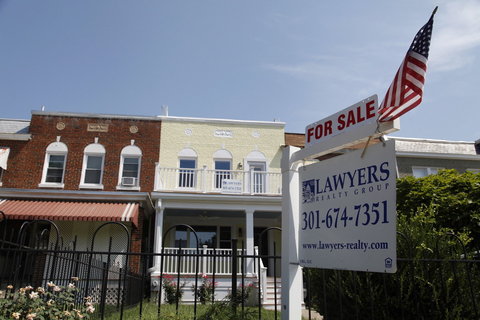 Reuters A home for sale in Washington, D.C.
Reuters A home for sale in Washington, D.C.
The number of homeowners who owe more on their mortgage than their house is worth continues to drop, but many borrowers still haven’t regained enough equity to afford to move, a new analysis finds.
About a quarter of all homeowners remain “underwater,” owing more than their home’s value, according to a first-quarter negative-equity report from the real estate site Zillow. That’s down from nearly 28 percent at the end of last year.
Zillow predicts the rate will fall to 23.5 percent by the first quarter of 2014, which will lift another 1.4 million homeowners into positive equity territory.
But for now, another 18 percent of homeowners with mortgages, while technically above water, still don’t have enough equity to make a move, bringing the current “effective” negative-equity rate to nearly 44 percent, Zillow says.
Technically, a homeowner reaches positive equity when the market value of the home exceeds the remaining loan balance. But listing a home for sale, and buying a new one, generally requires equity of 20 percent or more to comfortably meet related costs, like sales commissions and a down payment on a new home.
Such homeowners probably can’t afford a down payment, locking them into their current homes and helping to keep the inventory of homes for sale tight.
Without enough equity, such costs have to come out of a homeowner’s pocket, leaving many stuck, said Stan Humphries, Zillow’s chief economist. “You might not be underwater, but can you go out in the market and transact?” he said.
The “effective” negative-equity rate helps explain why healthy declines in the number of underwater borrowers haven’t yet translated into more homes for sale, he said.
The only cure, he said, is time. As rising home values continue to build equity, they will eventually get to the point where more homeowners can realistically sell.
Of the 30 largest metropolitan areas that Zillow tracks, those with the highest “effective” negative-equity rates — including homeowners with 20 percent equity or less — include Las Vegas, 72 percent; Atlanta, 64 percent; and Riverside, Calif., 60 percent.
Zillow’s negative-equity report looks at current outstanding loan amounts for owner-occupied homes, and compares them to those homes’ current estimated values. Loan data is provided from TransUnion, one of the three major credit-reporting bureaus. (Other reports estimate current loan balances based on the most recent loan on a property.)
Is a lack of equity holding you back from selling your home?
Article source: http://bucks.blogs.nytimes.com/2013/05/24/some-borrowers-need-more-equity-to-sell-homes/?partner=rss&emc=rss

